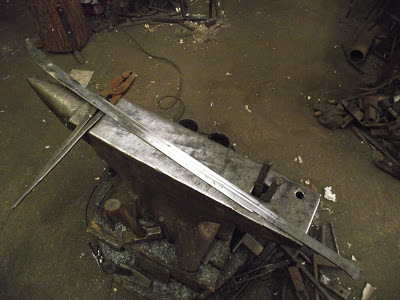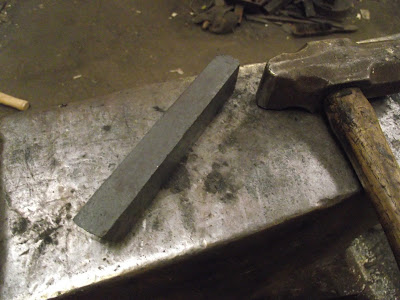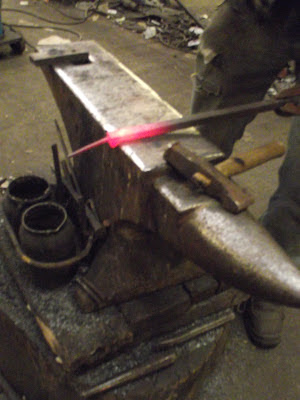Some time ago I was contacted by a customer to produce for
him a blunt, re-enactment sword in the style of a German “Grosse Messer”,
meaning literally “big knife”.
These weapons of the renaissance form an intriguing family
that take a variety of form and sizes, the style we elected for is of the
longest type, a “krieges Messer”, a “war knife", identifying it as a type exclusively
intended for use by the professional soldier of the day. What's unusual about that is that many of the Messers
were not exclusively for fighting; many occupied that intriguing place in the contemporary
society as tools, status symbols, civilian personal defence and hunting swords.
They existed as rudimentary Civilian implements and objects of the elite.
Their name “big knife” does not simply infer that they were
large single edge blades, but reveals something of their manufacture as they
were made by knife cutlers (a guild distinct from the sword cutlers) and also
exploited a legal loop hole of the time that a peasant could not own a sword,
yet there were no limits to what defined a knife, so knives became larger.
The design of this hand forged re-enactment sword was based
on several modern examples including the fine piece by Peter Johnsson, as well
as my own research on original pieces. The blade was forged from En9 carbon steel.
This is the story of the sword’s manufacture.
The starting stock for the blade was 20 inches of 40x10 En9
Once the outline of the sword had been formed with the
bevels roughed forged, the spare material in the tang end, was cut off to be forged into
a punch to cut the hole in the guard.
The design called for a double fuller to be forged in so a
tool was made to this,
forging from both sides of the blade simultaneously.
Once these were forged, it was time to begin hand
polishing the blade with files and
abrasives, the fullers were polished by wrapping 8mm diameter steel rods in
abrasive and rubbing in slow even movements to ensure that the fullers
terminates gracefully.
Once a rough polish had been achieved it was time to move on
to the hilt parts, these were all hand forged from mild steel using a range of
techniques.
The starting stock was a piece of 20mm square
This was knocked down to something like 16x 25.
The offcut from the tang was forged into a punch the same
width as the widest point on the tang (pommel end) and used to hot punch out
the slot.
Once the slot had been cut, the billet was marked out and the
sections that would become the quillions were separated using a top set
forged some time ago. Care was taken
not to intrude in to the newly punched slot, which would have damaged or
distorted it.
The blanks for the quillions were then drawn out under the
Goliath power hammer.
The Nagel hand guard was forged carefully from one piece.
A large rasp was used to set the shoulder before, finally, a
bolster was employ to upset the back and fully square the shoulder. The long
rivet or mortise would be trimmed shorter before final assembly of the guard.
After the clamour of forgework comes the inevitable fettling
and making of dust, quite course dust at this point, but dust all the same.
The cross piece and the nagel were shaped and formed with
files and abrasives until they were In a condition to marry.
These were fitted to the sword and progress could begin on fitting
the oak grip and the asymmetric pommel.
Once all the holes had been drilled and the timber fitted,
everything was secured.
Like in the originals, copper shims were carefully
fabricated do ensure absolute tightness.
Copper tubes with steel rods were used as rivets- this
exactly replicates the method used on originals.
The nagel guard was peened into a counter sunk hole on the reverse,
piercing the blade securely in position. Once the mortise had been peened it was nearly
invisible.
The timber was sealed with several protective coats of
linseed oil, which encourages any interesting aspects of the grain
tremendously.
This also prevents filth from the hands marking the wood and
the tannins from the oak staining the skin. The contrast between wood, copper
and steel was also increased and the object is left with a satisfying variety
of textures and colours.
Two astrological symbols were carved into the grip upon the customer’s
request and the piece was finished.
Thank you.










































Beautiful work! I'm a big fan of the grosse messer and kriegs messer style.
ReplyDeleteThis is lovely Josh!
ReplyDeleteMost interesting to learn about the distinctions characterizing the "big knife". Legal loophole for the non-gentry and manufacture by knife, rather than sword-makers - including scale handles. I had always puzzled over that one. Thank you for such an informative and interesting piece!
ReplyDeleteAnd your work is impressive - lethally beautiful "knife"!